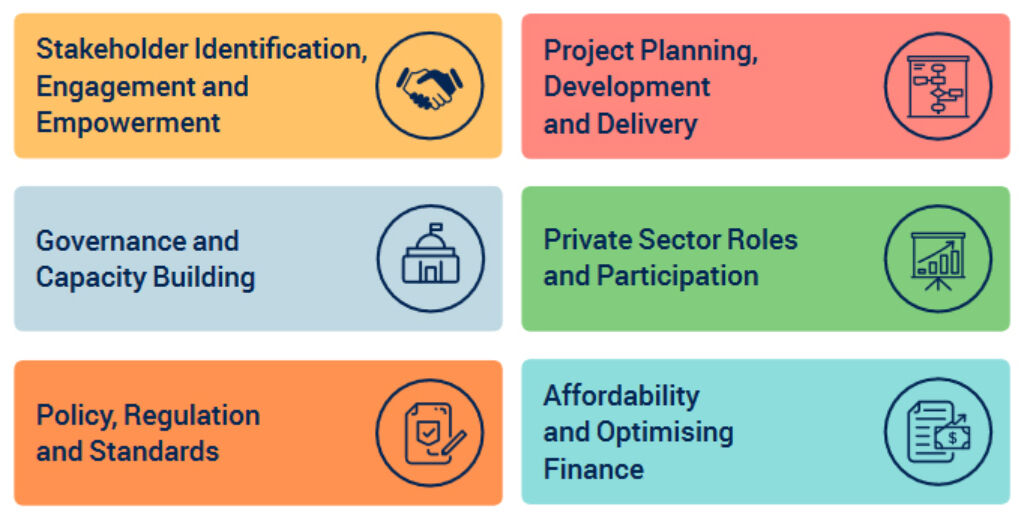The Government of Canada’s long-term investment plan for infrastructure is an opportunity to reshape the country through many direct and collaborative projects with the provinces, territories, municipalities, Indigenous partners, and the private sector.
In outlining key challenges and opportunities, the plan identifies regional differences, such as large versus small communities, as well as rural, northern and Indigenous communities that face particular infrastructure challenges. While this focus is not new for the federal government, the expansion of the definition of infrastructure to include “social development” and “inclusive infrastructure” is new.
In this context, inclusive infrastructure is understood as “any infrastructure development that enhances positive outcomes in social inclusivity and ensures no individual, community, or social group is left behind or prevented from benefiting from improved infrastructure.”
The sheer scale of public investment in infrastructure demands that we look to leverage this funding to advance public goals such as inclusivity. Through its Investing in Canada Plan, that the Government of Canada launched in 2016, it has committed over $180 billion over 12 years for infrastructure that benefits Canadians – from public transit to trading ports, broadband networks to energy systems, community services to natural spaces. To date, the Plan has invested over $119 billion in over 77,000 projects.
An inclusive framework
To better understand how an inclusive lens can be employed in infrastructure development, it is useful to view infrastructure as a holistic process. This process begins with identifying priorities for investment, followed by the design, procurement and implementation of projects, ending with the short- and long-term outcomes or benefits for communities from the investment.
There are opportunities to apply an inclusive lens throughout the different stages of this process, which ensures that infrastructure investments meet the needs of and benefit the maximum number of people. This view of infrastructure is captured in the Global Infrastructure Hub’s (GIH) Framework for Inclusive Infrastructure.
The GIH is a not-for-profit organization, formed by the G20, which advances the delivery of sustainable, resilient, and inclusive infrastructure. The framework sets out six actions areas, each of which include specific practices that can be employed in order to ensure inclusivity in infrastructure development.

- Stakeholder engagement: Stakeholder engagement is crucial to the successful delivery of any policy, program or project. It is particularly important to inclusive infrastructure because it can ensure those groups that are at risk of being excluded can participate in the priority setting, planning, design and implementation of infrastructure projects, as well as benefit from the assets once they are built/developed. With this in mind, it is essential that stakeholder engagement is included throughout the lifecycle of infrastructure programs.
- Governance and capacity building: In order to advance inclusivity, it is important that changes are built into “the structures, processes and systems that define decision-making, economic and social interactions within a community or country.” Certain practices to ensure inclusion in governance include transparency (e.g., open data) and accountability (e.g. measuring/reporting on outcomes), as well as capacity building for both historically under-represented groups and government staff to ensure a longer-term systems shift in governance.
- Policy, regulation and standards: To ensure that inclusive infrastructure can succeed, there needs to be clear and enforceable policies, standards and regulation in place. This is important to ensure a commitment to inclusion is actively undertaken and to ensure consistency in expectations for what inclusion looks like. These practices will implicate governments, standards bodies, as well as professional associations, unions, and the private sector.
- Project planning, development and delivery: Embedding inclusion into the project lifecycle of infrastructure ensures better participation and, ultimately, a better outcome for communities. This begins with setting terms for participation of under-represented groups in priority setting and planning committees, as well as a dedicated team that undertakes ongoing communication and dialogue with these groups throughout the lifecycle. Additionally, the use of tools, such as community benefits agreements, that outline specific deliverables, including training and employment for under-represented groups and local buying policies, ensures that diverse communities benefit from the new infrastructure and from the construction process itself.
- Private sector roles and participation: Many large-scale infrastructure projects in Canada are designed to be delivered, in whole or in part, through a partnership with private sector partners. As such, there needs to be clear parameters for these partners to build inclusion into their processes. This can be done by tying government funding to explicit deliverables in terms of inclusion, for example, through employment practices.
- Affordability and optimizing finance: Affordability refers to both whether governments can afford to build and operate infrastructure, as well as whether or not the end users can afford to access and use it. Means of raising revenue for the project need to ensure that whatever mechanisms are employed (i.e., tariffs or taxes) do not restrict who can use the infrastructure. Additionally, mechanisms can be put in place to ensure different groups have equitable access to infrastructure (e.g. affordable housing, subsidized transit fees). Many of these elements should be considered in a business case analysis that includes factors, such as inclusion, as part of the cost-benefit equation of the overall project.
The Canadian context
Within a Canadian context, there are recent examples of infrastructure investment that apply elements of an inclusive lens. Some of these examples include:
Canadian Active Transportation Strategy and Fund: In July 2021, the Government of Canada announced the country’s first-ever federal strategy and fund dedicated to building active transportation trails and pathways. As part of developing the strategy, the government sought input from the public and key stakeholders to explore options to deliver more transportation and recreation options, such as trails, cycling paths and other forms of active mobility in rural, urban and Indigenous communities. The strategy’s vision is “For Canadians of all ages, ethnicities, abilities, genders, and backgrounds to be able to safely and conveniently access active transportation in their communities and to significantly increase the ‘modal share’ of active transportation.” The strategy embraces targets and indicators beyond mode share, including greater diversity and inclusion, health and wellness, benefits on the environment, and business and tourism.
First Nation Infrastructure Fund: The Government of Canada administers the First Nation Infrastructure Fund (FNIF) to help First Nations communities upgrade and increase public infrastructure to improve the quality of life and the environment. The fund supports infrastructure projects on reserves, crown land or land set aside for the use and benefit of First Nations. Each year, First Nations communities are involved in setting infrastructure priorities in developing infrastructure investment plans that are shared with the Government of Canada. To provide transparency, data is published that shows ongoing and completed infrastructure projects in First Nations communities across Canada. The data includes feasibility studies, new construction and renovation, and capacity development projects. The information is exportable in an Open Data format for use by anyone to better understand and plan for future infrastructure needs.
Metrolinx: Metrolinx, the Ontario provincial agency that delivers transit infrastructure in the Greater Golden Horseshoe Region, recognizes that its major infrastructure investments should provide benefits for the communities in which they are built, including through employment and training, contracting local suppliers and social procurement opportunities. Following on this, Metrolinx has adopted a policy to include a community benefits program for rapid transit projects. The program has four principles: inclusivity, accessibility, transparency, and collaboration. These principles are achieved through agreements between communities and those building the infrastructure. The agreements articulate clear benefits as part of the build process, including, for example, employment and training opportunities for traditionally under-represented groups. The importance of community benefits programs is they can be effective in embedding inclusive standards and practices throughout the infrastructure project lifecycle.
Putman Family YWCA: In January 2019, the Canadian Housing and Mortgage Corporation announced a $10 million investment to rebuild the Putman Family YWCA in Hamilton. The project includes 50 affordable housing units, 35 of which are serving women and women-led families and 15 reserved for women with disabilities. The funding was part of the National Housing Co-Investment Fund (NHCF), in partnership with the Province of Ontario and the City of Hamilton. Along with the affordable housing units, a community hub was built on the ground floor of the building, offering child care, seniors’ and developmental services. It also houses the YWCA Hamilton Centre of Innovation, which targets training in non-traditional fields like advanced manufacturing and specialized technology, and mentorship services for women, girls and gender diverse people, as well as women entrepreneurs.
Next steps
The above examples highlight ways in which steps are already being taken to be more inclusive in approaches to infrastructure development. However, these approaches are not universal across jurisdiction or types of infrastructure investment. Additionally, while some methods currently in use show promise, they could be developed more fully. With this in mind, the following areas of further research will help create a more robust lens for inclusive infrastructure spending in Canada:
- Community Benefits Agreements (CBA): CBAs, like those used in the Metrolinx example, are a good mechanism to embed commitments to inclusion in the lifecycle of infrastructure projects. However, the approach to CBAs is not consistent across the country. Specifically, there is little standardization across levels of government (i.e., municipal/provincial/federal) as to what factors should be included in CBAs, nor who should be involved in their development. There are no set criteria on what metrics should be included, such as employment minimums or averages for particular groups. Additionally, there does not appear to be standardized methods of evaluation and enforcement to ensure CBAs are being upheld.
- Inclusive business case analysis: The use of a business case analysis to evaluate infrastructure is already a common practice. However, factors that help increase inclusion are not as central to these analyses as they could be. More research into better approaches to business case analysis to make inclusion a factor in project cost-benefit analyses should be conducted.
- Higher accessibility design standards: Increasing the accessibility of infrastructure to a higher standard, beyond legislative minimums, is another method in which to advance inclusion in infrastructure. One way to achieve this is through the incorporation of better accessibility design standards in infrastructure project agreements, including CBAs. While there are various standards published, the addition of accessibility as a commitment to increase inclusion in infrastructure is not evenly applied.
- Participatory budgeting for infrastructure: National infrastructure prioritization and spending has been, historically, an inter-governmental process that excludes the broader public. To be more inclusive, the public needs to be more centred in the process. One way to achieve this is by employing methods of participatory budgeting (PB). PB is typically used at community and local levels of government to help determine infrastructure spending priorities through increased participation, transparency and community capacity building. Using some of the same participatory budgeting techniques at the national level could be a way to inject these same advantages into the federal infrastructure spending process.
- Measuring inclusion: Affordability of and accessibility to infrastructure are important dimensions of inclusion. However, there are not established methods of measuring these factors for certain types of infrastructure. For example, there are accepted measures of what constitutes affordable housing across communities, but not what an affordable fee for broadband access should be. Further, what level of access to certain types of infrastructure is desirable from an inclusion perspective has yet to be established. For example, how far should a person be from transit service before it is deemed inaccessible?
Efforts are in place now to ensure that inclusion is part of infrastructure planning, as demonstrated by the Government of Canada’s current national infrastructure plan, the GIH framework for inclusive infrastructure, as well as the examples shared here. While this is a good start to the process, it is important to continue to develop and embed key principles and practices for inclusion into infrastructure planning moving forward.
-----
This article summarizes the findings of the report Inclusion by Design: Understanding Inclusive Infrastructure Investment in Canada. You can access the full report here.









